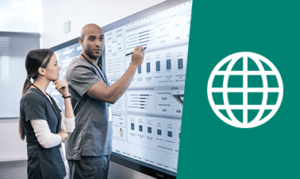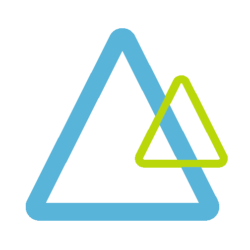Entry Level Software Development track
Nearly all tech that you engage with relies on software. The job outlook for software developers is growing year after year. Simply put, Software Developers are the people bringing the modern world to life.
Code builds everything!
Change your world with DataChangers and start with the Microsoft Entry Level Software Development track to discover the world of data! With these online courses it is possible to start a course wherever and whenever you want. All the courses are part of the Microsoft Professional Program.
The Microsoft Entry Level Software Development track exists of 13 steps to learn the basic skills of a software developers, focussed on artificial intelligence. This curriculum is designed for those that have never attempted programming. You will learn how to think logically and systematically through creating basic programs, developing interactive webpages, and understanding how to keep the user in mind in design, as well as analyzing algorithms and data for efficiency.
You don’t have to follow these courses in the specific order, but some of them are related. For every course you can obtain an official Microsoft Professional Program certificate, issued by Microsoft, for which you can buy a voucher from us (in collaboration with MD2C). All you need is your Windows LiveID to register with on the DataChangers Academy, and you will be ready to start your journey!
Steps of the Entry Level Software Development Track
- Logic and Computational Thinking
- Introduction to Python: Absolute Beginner
- Introduction to Python: Fundamentals
If you want some extra Python, then check out this course: Introduction to Python: Creating Scalable Robust Interactive Code - Designing a Technical Solution
- Building Interactive Prototypes using JavaScript
- Building Functional Prototypes using Node.js
- Learn to Program in Java
- Object Oriented Programming in Java
- Algorithms and Data Structures
- Writing Professional Code
- Introduction to Design Thinking
- Developing International Software
- Final Project with Microsoft
Explore the DataChangers Entry Level Software Development Courses

Logic and Computational Thinking
With this Logic and Computational Thinking course you build a solid foundation for programming by learning basic logic and exploring how logic forms the foundation of computer programs.
About This Course
Understanding how a computer “thinks” is one of the first steps to becoming an excellent computer programmer. A foundation in logic is crucial in developing this understanding. Mastering logic is more than learning a set of rules. It involves learning how to break problems into smaller chunks, figuring out how repeatable processes can save time and improve quality, and understanding how to organize problems into the right size.
In this course, you’ll learn how to do all those things and use computers to make them easier. After all, logical tasks are what computers are best at doing!
This is not a programming course, but it will teach you how to approach critical thinking as both a lifestyle and an aide to better programming and testing.

Introduction to Python – Absolute Beginner
In this Introduction to Python – Absolute Beginner course that’s perfect for true beginners, you learn Python basics and start coding right away.
About this course
This course is part of the Microsoft Professional Program in Entry-Level Software Development.
Brand new to text-based programming? Check out this hands-on course for an in-depth look at the details of Python layers and concepts. Get ample practice drills and projects, using Jupyter Notebooks on Azure, which require only a browser and an Internet connection. Learn best practices and begin coding almost immediately.
After you explore data types and variables, take a look at strings, input, testing, and formatting. From there, learn about arguments and parameters, along with conditionals and nested conditionals. By the end of the course, you’ll be able to create programs that prompt users for input and use conditional (True/False) logic and Python methods to manipulate numbers and text to provide responses to the users, in addition to requesting further input. Plus, learn basic troubleshooting for your code. Sign up, and get started coding right away!
Ready for next steps? Take the Introduction to Python: Fundamentals course.

Introduction to Python-Fundamentals
With this Introduction to Python-Fundamentals course you build on what you learned in the “Introduction to Python: Absolute Beginner” course, and dig into data structure basics.
About this course
This course is part of the Microsoft Professional Program in Entry-Level Software Development.
Ready for more hands-on, step-by-step Python fundamentals? Add to the foundational experience you got in the Introduction to Python: Absolute Beginner, and explore data structures. Get lots of practice working with sample code in Jupyter Notebooks on Azure, which require only a browser and an Internet connection.
Focus on Python data structures, and work with string, list, and range sequences. Discover the power of list iteration, and learn about string and list methods. From there, get the details on file input and output—open files, read them, add to them, close them, and more. At the end of the course, you’ll be able to slice strings into substrings, create lists, iterate through them, import files, and use file append mode, along with a lot of other practical Python tasks, as you get started coding.

Designing a Technical Solution
After this Designing a Technical Solution course you will be able to turn your idea into a prototype as you learn the process of designing and prototyping web applications to solve real problems.
About This Course
In this course you will learn the process of turning ideas into technical solutions. Early learners often need to learn context and the big ideas of a process before diving into the advanced details, and that’s exactly what you’ll get in this course. You’ll build upon your own idea for an app as you learn the process of conducting market research, user-centered design, and front-end web development. By the end of the course, you will have a user-centered design, wireframes and specification for a web app, along with a front-end user interface built with HTML and CSS.

Building Interactive Prototypes using JavaScript
With this Building Interactive Prototypes using JavaScript course you will learn skills from programming basics to DOM manipulation, and how to use JavaScript, the programming language of the Web, to create interactive webpages.
About This Course
In this course, you’ll learn how to turn a static web front-end into something that users can interact with. You’ll learn the fundamentals of JavaScript and how to apply JavaScript to enhance the interactivity of webpages. By the end of this course, you’ll have a web app prototype that allows basic interaction.

Building Functional Prototypes using Node.js
With this Building Functional Prototypes using Node.js course you will learn the basics of back-end web development as you create a simple web application server using Node.js.
About This Course
In this course, you’ll learn all about back-end web development so that you can turn a basic web app prototype into something that can store live data. We’ll cover the basics of Node.js so that you can write JavaScript code to build the back-end of your app, as well as the basics of SQL and SQLite to write queries to work with a database. By the end of this course, you’ll have a functional web app prototype that can be accessed on the Web.

Learn to program in Java
With this Learn to Program in Java course you get started on the path to becoming a software engineer by learning core coding skills in Java—one of the most popular programming languages.
About This Course
Ready to start your programming journey? Being a software engineer is much more than simply writing code—it requires a strong conceptual understanding of computer science. In this course, which was developed through a combination of academic and industry perspectives, learn not only how to code in Java but also how to break down problems and implement their solutions using some of the most fundamental computer science tools.
Get plenty of hands-on Java coding experience with methods, logic, loops, variables, parameters, returns, and recursion. And write your code using industry-standard tools and practices to help you build strong habits as you grow your development skill set.
Whether you are preparing for advanced university computer science courses, an entry-level software engineering position, or the Advanced Placement Computer Science A exam, get the tools you need to succeed in this practical, self-paced Java course.

Object Oriented Programming in Java
With this Object Oriented Programming in Java course you learn that one of the most important skills in software development is designing how code is organized. In this Java course, learn how to apply industry-standard practices as you structure your software.
About This Course
What do hiring managers look for in entry-level developers? According to a recent survey, one of the most requested job skills is “strong object oriented design”. Yet traditional computer science programs rarely focus on this area.
In this Java course, examine the role of objects in code, explore how to use them, and see how to design them for optimal code reuse and structure. Get tons of hands-on coding experience using popular Java objects, like Arrays and Lists, and then leverage those learnings to design your own object hierarchies. Plus, practice using inheritance, interfaces, abstract classes, and encapsulation techniques to help you manage large code bases.
Get comfortable employing industry standards in designing and managing complex relationships within a code base, as you add to your computer science skill set.

Algorithms and Data Structures
With this Algorithms and Data Structures course you will learn how to write faster and more efficient code against the backdrop of famous algorithms.
About This Course
Want to build better programs? Learn how, in this professional-level course.
Bring your programming experience, and join us for a deep dive into fundamental concepts that you can use right away. Go underneath the hood of functional algorithms and data structures, and see how they work and how to compare them. Plus, get the details on when and how to use them.
In this real-world-tested curriculum, take a look at famous algorithms and equations, and see how yours stack up. See practical demos, compare “life scenarios” to their coding counterparts, and create an app for your final project.
Add to your developer toolkit with this in-depth exploration of algorithms and data structures.

Writing Professional Code
With this Writing Professional Code course you will learn that writing professional code is a team sport. Learn how to elevate your game to the next level.
About This Course
“Professional” sounds boring, right? Wrong! Join expert Andrew Byrne, who has more than 25 years of software development experience, and see how fun it can be to apply your coding skills to actual problems. Create an online portfolio of code on GitHub, and receive feedback from your peers through code reviews and discussions.
Being a professional developer is about managing change, evolving a codebase, maintaining quality, and keeping your users and your business safe.
As a new coder, step up your game as you learn and practice key skills that developers use every day. Work with a collection of code in a version control system like Git, use open source (OSS) libraries, make updates to existing code, improve its readability, and even take a look at security. Don’t miss this opportunity to be part of the team, and get practical experience with real code in a real coding environment.

Introduction to Design Thinking
This course is a creative process that combines thoughtful user research with rapid iteration. Learn why it becomes an industry standard all over the world.
About this course
This course is part of the Microsoft Professional Program in Entry-Level Software Development.
Want to take your design skills to the next level? Join a team of industry experts on this practical and informative journey from concept to conclusion.
This course will introduce you to the Design Thinking process and illustrate best practices for each step along the way. You’ll find this is an incredibly powerful tool for any field: from Engineering to Entrepreneurship and beyond.
You will utilize everything you learn in this course to create your very own project. In doing so, you will learn many practical and applicable skills such as user research and rapid prototyping, which will set you apart in your field.

Developing International Software
This course is part of the Microsoft Professional Program in Entry-Level Software Development.
When you’re designing and developing new software, it’s easy to get laser-focused on getting it functional and into the market or deployed as soon as possible. Thus, many engineering teams develop software that supports their native language first, postponing support for other languages until “later,” when they think they will have the bandwidth. In other words, they don’t plan ahead. The problem with this approach, which experienced developers have found out the hard way, is that it sacrifices budget, time, and opportunity.
Redesigning and rebuilding a different edition of your software for each and every language or market can be a colossal effort. As this computer science course will demonstrate, planning ahead is far more efficient, and the marginal cost of supporting multiple languages from the get go is less than you may think. Harnessing international functionality in operating systems and programming languages makes writing code that works for multiple languages and markets much simpler than retrofitting existing code.
The instructors for this course include programmers who have worked on globalization and localization of some of the world’s most successful software. They’ve experienced the good, the bad, and the ugly of creating world-ready software, and they’re here to ensure your software’s user experience works consistently, regardless of where users are from or what languages they speak.
This course has three parts: the business case, world-ready design, and world-ready development. While students can complete parts one and two without programming knowledge, part three requires programming experience.


